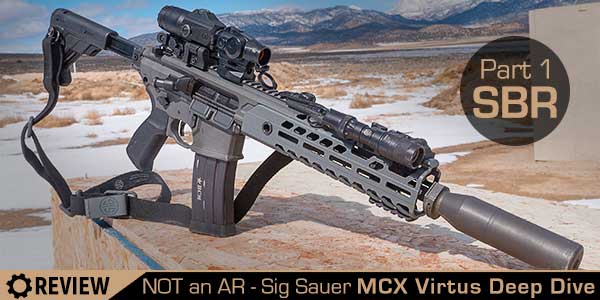 When Sig Sauer introduced its MCX it was mostly a rifle caliber MPX to me, anything but earth shattering. After testing hundreds of AR’s, getting excited about anything AR is difficult. Having tested a bunch of Sig Sauer firearms, they always seem well thought out and thoroughly tested. Many of their rifles have been military submissions or simple unit requests. So, when invited to a media event introducing the latest MCX, the Virtus, it was mildly interesting. My “just another piston AR” filter went up quickly. By the end of the event that had all changed.
When Sig Sauer introduced its MCX it was mostly a rifle caliber MPX to me, anything but earth shattering. After testing hundreds of AR’s, getting excited about anything AR is difficult. Having tested a bunch of Sig Sauer firearms, they always seem well thought out and thoroughly tested. Many of their rifles have been military submissions or simple unit requests. So, when invited to a media event introducing the latest MCX, the Virtus, it was mildly interesting. My “just another piston AR” filter went up quickly. By the end of the event that had all changed.
While the piston system is similar to most short stroke gas systems, there is no buffer tube or buffer in the MCX, it’s all inside the upper receiver. An adapter allows an MCX upper to work on a standard lower, but they are otherwise incompatible. Even the trigger is different, looks the same, operates the same, but it’s different. Based on the MPX it was designed ground up as a stand-alone system. Barrels are tapered to fit their suppressors and muzzle devices but can be adapted if needed. Stocks attach to a PIC rail that can fold or extend, and the rifle is fully functional without a stock or folded. Barrels can be switched in a minute or two and the handguards can be removed without tools. Using it for a few days at the event was fun; taking the entire kit home with me using it over several months it has become one of my favorite rifles.
Using the WHOLE NINE YARDS!
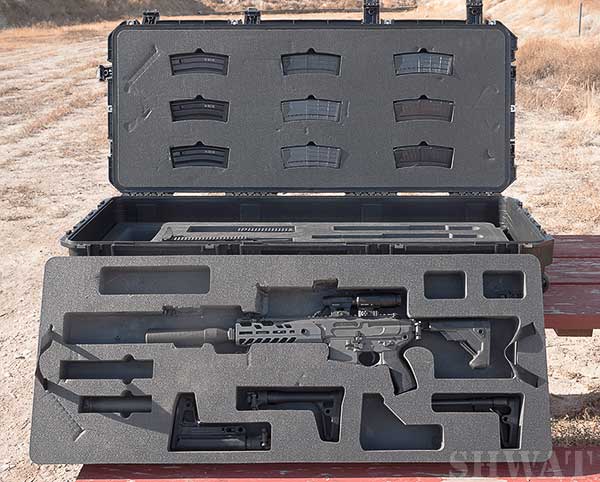 Being a Title II manufacturer has its advantages. It meant everything used at the event could be sent to me for testing. That included four barrels ranging from a 5.5” 300 BLK to a 16.5” 556 NATO. Four hand guards from eight to fifteen inches. Three suppressors, the SRD556-QD, SRD762Ti-QD and SRD762Ti direct threat (5/8 x 24). Every barrel used the Sig QD mount except the 5.5” 300 BLK. Sig Sauer Electro Optics Tango 6 1-6 was supplied along with a Romeo 4T RDS and a matching Juliet 4 magnifier. Iron sights were provided along with a sling. Several Lancer magazines along with a couple PMAGs fitted in the top of the case. I have since acquired their Tango 6 3-18 power scope. Sig Sauer sent me an MCX chambered in 300 BLK using a 16.5” base rifle adding another barrel to the mix. They also sent me the MCX Rattler, a very short barreled, (or in this case a pistol) 300 BLK. It will fit on the latest MCX Virtus lower. Upon arrival, I manufactured the Virtus as an SBR so everything in the case could be legally fielded including the Rattler.
Being a Title II manufacturer has its advantages. It meant everything used at the event could be sent to me for testing. That included four barrels ranging from a 5.5” 300 BLK to a 16.5” 556 NATO. Four hand guards from eight to fifteen inches. Three suppressors, the SRD556-QD, SRD762Ti-QD and SRD762Ti direct threat (5/8 x 24). Every barrel used the Sig QD mount except the 5.5” 300 BLK. Sig Sauer Electro Optics Tango 6 1-6 was supplied along with a Romeo 4T RDS and a matching Juliet 4 magnifier. Iron sights were provided along with a sling. Several Lancer magazines along with a couple PMAGs fitted in the top of the case. I have since acquired their Tango 6 3-18 power scope. Sig Sauer sent me an MCX chambered in 300 BLK using a 16.5” base rifle adding another barrel to the mix. They also sent me the MCX Rattler, a very short barreled, (or in this case a pistol) 300 BLK. It will fit on the latest MCX Virtus lower. Upon arrival, I manufactured the Virtus as an SBR so everything in the case could be legally fielded including the Rattler.
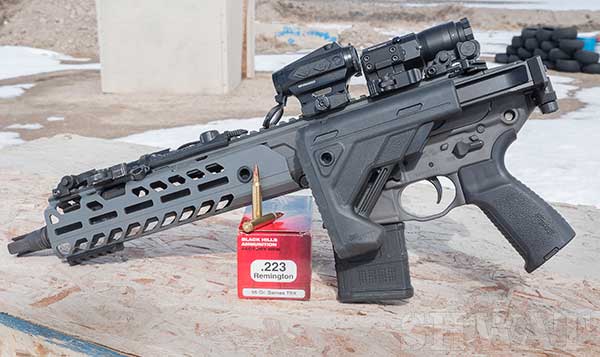 This is not the only system able to configure various barrel lengths, stocks or other accessories. Over the years I have tried to get companies with similar modular rifles to send me multiple barrels. You would think I was asking to borrow their first born. They either would not, or just could not produce the actual product. In many cases it was all hype, you could not get the rest unless you were some government agency or secret squirrel. Or they want you to buy everything. But Sig Sauer stepped up with this MCX and I wanted to get them some in depth coverage, something more than a few groups at 100 yards and an action shot.
This is not the only system able to configure various barrel lengths, stocks or other accessories. Over the years I have tried to get companies with similar modular rifles to send me multiple barrels. You would think I was asking to borrow their first born. They either would not, or just could not produce the actual product. In many cases it was all hype, you could not get the rest unless you were some government agency or secret squirrel. Or they want you to buy everything. But Sig Sauer stepped up with this MCX and I wanted to get them some in depth coverage, something more than a few groups at 100 yards and an action shot.
Getting magazines to publish anything with detail is about impossible today, it would be easier to get the truth out of a politician (or CNN). Drive by reviews covering guns that were barely tested (if at all) seem to be the rage. Many are nothing but regurgitation of the specs on the web page after a couple boxes of ammo down range. Every publisher I approached about this series said “it looks like advertising” and we don’t want to appear biased? Once I stopped laughing I decided to hit up Jonathan here at SWHAT™. Given my Pro Staff position and his willingness to work outside the box it seemed a good match and I think it will be, thanks to Jonathan for taking a chance.
So, this series will be regular, at least monthly, covering every configuration I can put together using a single Sig Sauer MCX Virtus lower and multiple barrels, calibers, handguards, stocks, optics, and other accessories. Call it the many faces of the MCX if you like, but each will be tested thoroughly as they would be used, call it an experiment in reality.
Sig Sauer MCX Virtus SBR
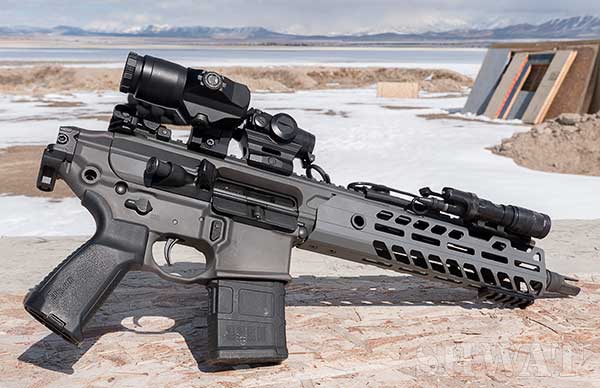 The most common configuration in the police world today is a 5.56mm using a 10 – 12 inch barrel. It keeps things light, easy to maneuver in tight spaces and provides the ability to store it in racks, bags, packs, or in the trunk. Kind of the perfect truck gun and you get usable ballistics out to any realistic range, especially with today’s ammunition. It’s listed on the Sig Sauer Website as the “SBR” available in both 5.56 NATO and 300 BLK. This rifle is configured in 5.56 NATO with the 11.5 inch 1:7 twist barrel. All MCX barrels are cold hammer forged and Nitride treated. Threaded ½ x 28 it uses Sig’s tapered design, but an adapter is provided for use with other muzzle devices. Since muzzle brakes are usually a no go for me, their three pronged flash hider attachment was added. It works great alone and you can still attach their SRD556-QD suppressor. I used the standard 5 position folding stock that comes with the Virtus and the 10” hand guard. Sig Sauer’s flip up BUIS irons were used along with a Romeo 4T RDS and 4J magnifier. These were not new, used them at the event, and they look to be demo units, but they have been flawless to date. Sling is a two point Blueforce made for Sig Sauer to include their markings and color scheme. Carry magazine is a Gen3 20 round PMAG loaded with Black Hills 55 grain Barnes TSX, the remaining magazines are BCM Teflon Coated Mil-Spec Aluminum with Magul (green) followers and CTT Solutions magazine pads. These have been absolute workhorses used over several years and dozens of rifle tests. They work in every rifle ever tested and have held up to incredible abuse.
The most common configuration in the police world today is a 5.56mm using a 10 – 12 inch barrel. It keeps things light, easy to maneuver in tight spaces and provides the ability to store it in racks, bags, packs, or in the trunk. Kind of the perfect truck gun and you get usable ballistics out to any realistic range, especially with today’s ammunition. It’s listed on the Sig Sauer Website as the “SBR” available in both 5.56 NATO and 300 BLK. This rifle is configured in 5.56 NATO with the 11.5 inch 1:7 twist barrel. All MCX barrels are cold hammer forged and Nitride treated. Threaded ½ x 28 it uses Sig’s tapered design, but an adapter is provided for use with other muzzle devices. Since muzzle brakes are usually a no go for me, their three pronged flash hider attachment was added. It works great alone and you can still attach their SRD556-QD suppressor. I used the standard 5 position folding stock that comes with the Virtus and the 10” hand guard. Sig Sauer’s flip up BUIS irons were used along with a Romeo 4T RDS and 4J magnifier. These were not new, used them at the event, and they look to be demo units, but they have been flawless to date. Sling is a two point Blueforce made for Sig Sauer to include their markings and color scheme. Carry magazine is a Gen3 20 round PMAG loaded with Black Hills 55 grain Barnes TSX, the remaining magazines are BCM Teflon Coated Mil-Spec Aluminum with Magul (green) followers and CTT Solutions magazine pads. These have been absolute workhorses used over several years and dozens of rifle tests. They work in every rifle ever tested and have held up to incredible abuse.
Accuracy
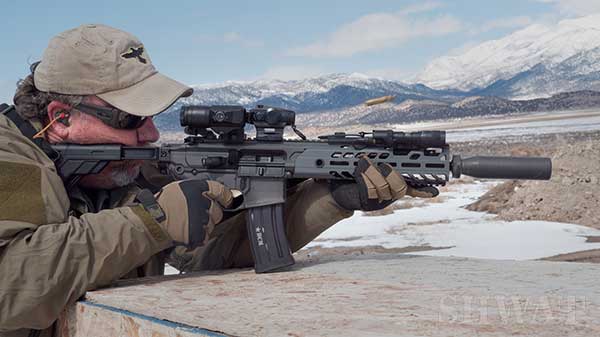
Every MCX barrel tested has been accurate. Clean, dirty, hot, cold, no matter, they all shoot sub MOA, most of them significantly. This rifle is configured as my “truck gun” and unless being used for some testing is generally close at hand. It’s the rifle used on the rare occasions I can actually practice, it goes with me on trips, training, it’s one of two AR’s I trust my life with, the other is a Primary Weapons Mod 2 M111. At least once a week this MCX is checked for
zero using the Black Hills 55 grain TSX. Red Dot is set up using the CirclePlex, a broken outer circle with a duplex (cross) in the center. Zeroed at 50 yards I confirm both with and without the magnifier. It has yet to produce a group using the Black Hills over .75 inches, a few close to .50 inches. During a couple reviews it has produced .60 inch groups using the Sig Sauer 77 grain OTM at 100 yards. Even the M855 green tip has been under an inch at 50 yards, a tad over at 100 yards. It seems to favor the 55 grain ammunition, but it shoots it all plenty accurately. Roughly four times as accurate as the “standard” I deployed with for years.
Every expert out there seems to underestimate the capability of the short barrels. You still have people regurgitating things like it’s a “100 yard rifle”. That wasn’t true 20 years ago the first time I fielded an 11” AR and it’s still BS. Out to 300 yards this rifle is deadly accurate hitting 10” round steel pretty much at will using the magnifier and the Romeo 4T. Adding an optic using Black Hills 69 or 77 grain TMK and it gets regular hits out to 500, even 600 meters. Is it a DMR? Of course not, but even with this 11 inch barrel it is a 300 meter rifle all day long and longer with the right ammunition and optic. I’ve found plenty of people willing to yap all day about its ineffectiveness at 500 yards. Funny, none seem willing to let me test that theory or listen to those who have in combat.
Reliability
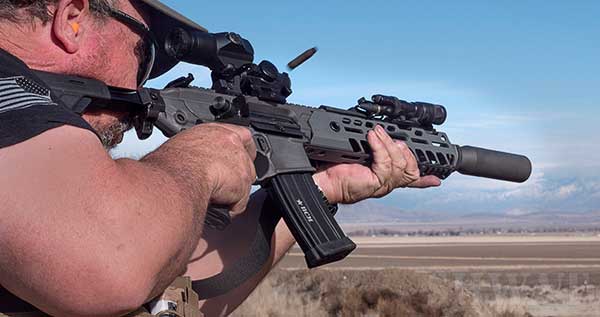
A very trusted former ODA team leader and SMU (Special Missions Unit) member with 20 plus years and numerous deployments told me this version of the MCX was the “most heavily tested AR style rifle in the SMU community.” Sig Sauer claims no need for replacement parts within 20,000 rounds, he explained how it had been confirmed not only by Sig Sauer, but the SF community. For us mere mortals that’s a couple lifetimes. Over the course of the last few months this MCX has yet to fail in any configuration or caliber. Suppressed, unsuppressed, any gas position, folded, even with no stock attached it just kicks out the brass every single time. Tested from -8 to 80 degrees in four different states it’s yet to fail. Using the “suppressed” setting on the two position gas block gets you a softer rifle, but it runs either way. I have a couple other rifles that have been as reliable, none more so, and even then you can count them on one hand, especially with an 11 inch barrel, it just does not get better.
Other Thoughts
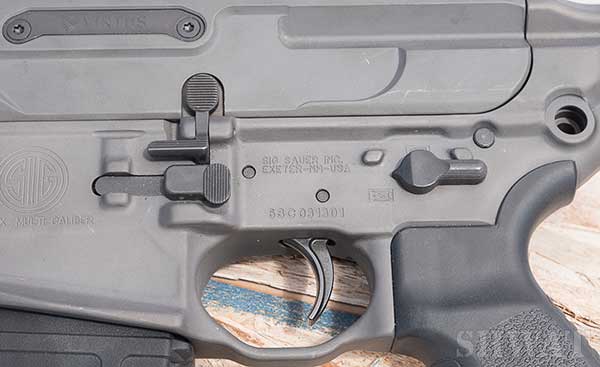 Swapping things out is simple and fast requiring a Torx for the barrel mounting and stock, Allen wrench for sight changes (if you do that), and a ½ inch wrench for the Tango 6 and Romeo 4T. A torque wrench is nice, not necessary for field expedient use, but plan on it. If you are going to swap out the Sig muzzle devices you need a wrench for that. The only odd tool is the 35mm wrench for the SRD556mm QD suppressor. You can get their tool, probably the best way to go. I used a fan clutch (36mm) wrench for the 5.56mm with no issues. That’s it and you can make all the changes you need.
Swapping things out is simple and fast requiring a Torx for the barrel mounting and stock, Allen wrench for sight changes (if you do that), and a ½ inch wrench for the Tango 6 and Romeo 4T. A torque wrench is nice, not necessary for field expedient use, but plan on it. If you are going to swap out the Sig muzzle devices you need a wrench for that. The only odd tool is the 35mm wrench for the SRD556mm QD suppressor. You can get their tool, probably the best way to go. I used a fan clutch (36mm) wrench for the 5.56mm with no issues. That’s it and you can make all the changes you need.
Sig Sauer’s trigger is not bad, it’s no Geissele, but it’s far better than your standard trigger. It was 100 percent reliable, completely predictable, and allowed for precision when needed. Many will never see a need for change, and it is perfectly suited for law enforcement or other professional use. Geissele makes one, Timney is working on it so choices are out there and will increase.
Adding the SRD556-QD suppressor changed the zero at 50 yards less than in inch. It adds a few inches in length and about 15 ounces. Made of Inconel 718 it is as strong as it gets and is designed for this barrel length. It’s quiet, quieter than most. Turn the gas down and there is very little gas in your face with a repeatable three o’clock ejection pattern. Runs fine wide open, just more gas and ejection closer to one o’clock. Accuracy is completely unaffected.
Folded without the suppressor it fits in a few less than tacticool backpacks and sits easily in a truck or vehicle. The fact you can use it folded is a plus when deploying quickly or in tight spaces. Everything but the bolt release is ambidextrous, and that has a nicely extended lever to make it easy to lock the bolt open. Charging handle is ambidextrous without extending into the next county. Right side safety is shorter but not so short you can’t use it. Folded using the Virtus stock you can access both safeties and the right side magazine release. Move to the Rattler Stock and you can get to everything on both sides.
Bottom Line
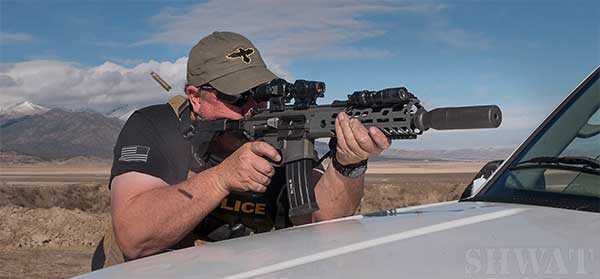 This is a great carbine, not sure it gets any better. Others are as reliable, some modular, none out there as modular as this. Definitely none that have six different stocks, about as many hand guard lengths, and multiple barrels. Some are more accurate, but anything under .75 at 100 is better than most humans can shoot so it really does not matter. Besides, it’s not a precision rifle, it’s a carbine, one designed for combat or duty use not the PRS.
This is a great carbine, not sure it gets any better. Others are as reliable, some modular, none out there as modular as this. Definitely none that have six different stocks, about as many hand guard lengths, and multiple barrels. Some are more accurate, but anything under .75 at 100 is better than most humans can shoot so it really does not matter. Besides, it’s not a precision rifle, it’s a carbine, one designed for combat or duty use not the PRS.
It’s not cheap, but at $2233.00 retail nor is it expensive by comparison. It’s a grand less than a SCAR 16 or MR556A1 and only a few hundred more than many high quality DI guns with none of the modularity. Is it for everyone? Absolutely not, but you get a ton of features for your money. If you are into the “one gun” game, this should be at the top of the list, especially since you can turn that “one” rifle into about ten in just a couple minutes! Stay tuned, subscribe to the newsletter for updates, and you will see just how many rifles you can actually configure using this “one gun.”



So, got any pictures of those all-day sub-MOA groups?
Bahde is one of the most reputable guys in the industry. Check his bio here, maybe follow him on social. He is a trusted SME in many places, including the courts. Sorry we don’t have pics.
can you identify the case for me? i recently put together a MCX kit and am looking for hard case like that.
Do you have any info on the foam used in the case? I have an MCX and with such a nice weapon I would like the foam to be more sturdy than the typical pluck foam in my Pelican 1700.
From the author: Looks like it is an SKB, closest I can find to what I measure is this one http://skbcases.com/sports/sku.php?cat=27&pid=46 That matches the usable dimensions. The foam is custom cut for Sig Sauer in this one.
What is the weight without the suppressor ?
According to https://www.sigsauer.com/store/sig-mcx-virtus-sbr.html the SBR weight varies between 7.4 and 7.9 pounds, depending on model.
What light mount is that? I need to do an offset for my virtus and this one looks nice.
Larue Tactical’s surefire scout offset mount
Well written article. I will continue to read your publishings’. I am an ex-Combat Arms Training and Maintenance Speciaist (CATM) for the USAF and have shot most firearms used by our personnel. I typically do not get excited about another AR configuration but I want this piece in my inventory and it will become my “trunk gun” for every occasion.
Cheers!
Will lower third ar optic mounts work on this weapon or would that be too high?
They will work fine.